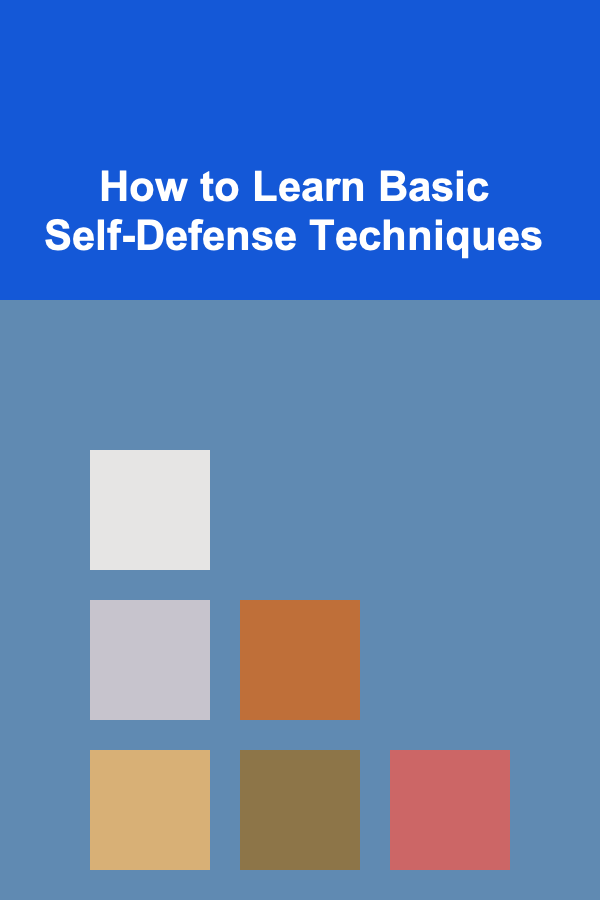
How to Learn Basic Self-Defense Techniques
ebook include PDF & Audio bundle (Micro Guide)
$12.99$7.99
Limited Time Offer! Order within the next:

Self-defense is an essential skill that everyone should consider learning. It's not just about protecting oneself from harm, but also about fostering confidence, building awareness, and understanding how to react in potentially dangerous situations. In today's world, where personal safety can sometimes be at risk, knowing how to defend oneself can be empowering.
This article will explore the fundamental self-defense techniques that anyone can learn, why self-defense is important, and how you can get started on your own journey to learning these life-saving skills.
The Importance of Learning Self-Defense
Before diving into the techniques themselves, it's important to first understand why self-defense is crucial. There are numerous reasons why someone might want to learn self-defense:
1. Personal Safety
The most obvious reason to learn self-defense is to protect yourself from potential threats. Unfortunately, dangerous situations can arise unexpectedly, and being able to defend yourself can make the difference between escape and harm. Whether you're walking alone at night or find yourself in an unfamiliar environment, knowing how to protect yourself adds a layer of security to your life.
2. Building Confidence
Learning self-defense builds confidence. Knowing that you have the tools to handle a variety of situations helps to reduce fear and anxiety. When you're confident in your abilities, you're less likely to be easily intimidated and more likely to keep calm in high-pressure situations.
3. Physical Fitness
Self-defense training is also a great way to improve your overall physical fitness. Many self-defense techniques involve strength, coordination, and endurance, which can help you stay in good shape. Regular training builds muscle, increases flexibility, and improves cardiovascular health.
4. Enhancing Mental Awareness
Self-defense isn't just about physical skills; it also involves situational awareness. Being aware of your surroundings and recognizing potential threats can help you avoid danger before it becomes a physical confrontation. Training in self-defense teaches you how to stay alert and think quickly under stress.
Key Principles of Self-Defense
Before we get into the specifics of techniques, it's important to understand a few core principles that underlie all self-defense strategies:
1. Avoidance
The best form of self-defense is avoidance. Whenever possible, try to avoid dangerous situations. Trust your instincts and don't hesitate to remove yourself from an area if you feel uncomfortable. Whether it's leaving an unfamiliar neighborhood or staying away from a potential confrontation, de-escalating a situation is always the smartest course of action.
2. Protection of Vital Areas
Self-defense is not about winning a fight or proving strength; it's about neutralizing a threat. Focusing on protecting vital areas---such as your head, neck, groin, and joints---is critical. You don't need to overpower an attacker; instead, target areas that will give you the leverage to escape.
3. Using Your Environment
Your surroundings can be powerful tools in self-defense. Using objects like bags, umbrellas, or even furniture can help you defend yourself. The environment around you might offer opportunities to block an attacker's strikes or to create distance between you and the assailant.
4. Surprise and Speed
Attacking your opponent by surprise can disorient them, giving you the advantage. Striking quickly and decisively is vital in self-defense, as attackers usually rely on overpowering their victim, which can be mitigated by quick reactions and decisive actions.
5. Mental Focus
Your mindset is just as important as physical ability. Staying calm and focused during an encounter is key to reacting effectively. Panic can cloud judgment, while a calm, clear mind allows you to assess the situation and make sound decisions.
Basic Self-Defense Techniques
Now that we've covered the importance and principles of self-defense, let's dive into some basic self-defense techniques that can help you in various situations. These techniques can be learned through classes or online resources and practiced regularly to enhance their effectiveness.
1. Escape from Grabs
One of the most common attacks in a confrontation is a grab or hold. Learning how to escape from these grabs can give you the chance to create space and run away or counterattack.
-
Wrist Grab Escape If someone grabs your wrist, don't pull away directly, as this will likely only make the hold stronger. Instead, rotate your wrist in the direction of the grab to break free. You can then follow up with a quick strike to the attacker's face or eyes to create distance.
-
Bear Hug Escape When someone wraps their arms around your torso (bear hug), use your hips to break their grip. Drop your weight down, lower your center of gravity, and use your elbows or knees to strike their body. You can also use the opportunity to step to the side and break free.
2. Striking Techniques
Strikes to vital areas are often the most effective way to disable an attacker temporarily. These techniques can give you the chance to escape or gain control of the situation.
-
Palm Strike Instead of using a punch (which could injure your hand), use the heel of your palm to strike your opponent's nose, chin, or chest. The palm strike is quick and powerful and reduces the risk of injury to your hands.
-
Knee Strike A knee strike to the groin or the stomach can incapacitate an attacker. By raising your knee quickly, you target a vulnerable area of the body, causing pain and allowing you time to flee or follow up with additional strikes.
-
Elbow Strike The elbow is one of the hardest parts of your body, and striking with it can be highly effective. If an attacker is close to you, use your elbow to strike them in the face, neck, or ribs.
3. Kicking Techniques
Kicks can create distance between you and the attacker and can be used effectively in self-defense. It's crucial to aim for vulnerable areas, such as the knees, groin, or chest.
-
Front Kick A well-executed front kick to the midsection or the knee can throw off an attacker's balance, buying you valuable time to escape. Aim for the soft tissue around the groin or the lower abdomen for maximum impact.
-
Roundhouse Kick A roundhouse kick can be used to strike the side of the attacker's head, torso, or legs. The key to a successful roundhouse kick is flexibility and precision. Practice the technique to ensure the kick is powerful and controlled.
4. Defensive Postures
How you position yourself in an attack situation can help you avoid being struck or restrained. Good posture and defensive stances help you stay ready to respond to attacks.
-
The Fighting Stance Stand with your feet shoulder-width apart, knees slightly bent, and hands raised to protect your head and face. Keep your weight balanced so you can move quickly and adjust your posture as necessary. This stance provides a strong base for any defensive action.
-
The Guard Position If someone approaches you aggressively, use the guard position, which involves raising your hands to protect your head and keeping your body slightly turned to avoid being a target. This stance allows you to be alert and ready to respond with strikes or movement.
5. Escaping Holds and Chokes
When an attacker tries to choke you or holds you from behind, it's essential to stay calm and react quickly.
-
Rear Choke Escape If an attacker chokes you from behind, don't panic. Drop your chin to your chest to protect your throat, then use your hands to try to break the hold by grabbing the attacker's arms and pulling them off. You can also kick the attacker's legs to destabilize them and break free.
-
Choke with One Arm Escape When an attacker uses a one-arm choke, grab the arm that's choking you, and use your opposite hand to strike their face or eyes. This creates enough disruption for you to break the hold and escape.
How to Start Learning Self-Defense
Now that we've covered some basic techniques, here's how you can start learning self-defense:
1. Enroll in a Self-Defense Class
The most effective way to learn self-defense is through professional instruction. Many martial arts schools offer classes specifically designed to teach self-defense, such as Krav Maga, Brazilian Jiu-Jitsu, or Muay Thai. A trained instructor can guide you through techniques and provide personalized feedback.
2. Practice Regularly
Like any other skill, self-defense requires practice. You can practice the techniques you've learned in class at home or with a training partner. Consistent practice helps reinforce muscle memory, making it easier to react instinctively in real-life situations.
3. Stay Fit
Physical fitness is a critical component of self-defense. Regular exercise, including strength training, cardio, and flexibility workouts, will improve your endurance, strength, and overall ability to defend yourself.
4. Simulate Real-World Scenarios
Once you've learned the basics, it's important to simulate real-world scenarios. Practice defending yourself against various types of attacks, such as grabs, punches, and chokes. This helps you prepare for the unpredictability of actual confrontations.
Conclusion
Learning basic self-defense techniques is an empowering and essential skill that everyone should consider. By understanding the core principles of self-defense, practicing key techniques, and maintaining a strong mental and physical foundation, you can increase your personal safety and confidence. Whether through classes, self-study, or consistent practice, self-defense can help you protect yourself in dangerous situations and provide you with the tools to stay safe and aware.

How to Create Travel Content for Social Media and Generate Income
Read More
How to Play Role-Playing Games (RPGs) Like a Pro
Read More
How to Protect Your Home from Fire Hazards with Simple Maintenance
Read More
How to Use Baskets and Bins for Outdoor Toy Storage
Read More
Choosing the Right Sifter for Fine Flour and Dry Ingredients: A Comprehensive Guide
Read More
How to Build Credit After Bankruptcy
Read MoreOther Products

How to Create Travel Content for Social Media and Generate Income
Read More
How to Play Role-Playing Games (RPGs) Like a Pro
Read More
How to Protect Your Home from Fire Hazards with Simple Maintenance
Read More
How to Use Baskets and Bins for Outdoor Toy Storage
Read More
Choosing the Right Sifter for Fine Flour and Dry Ingredients: A Comprehensive Guide
Read More